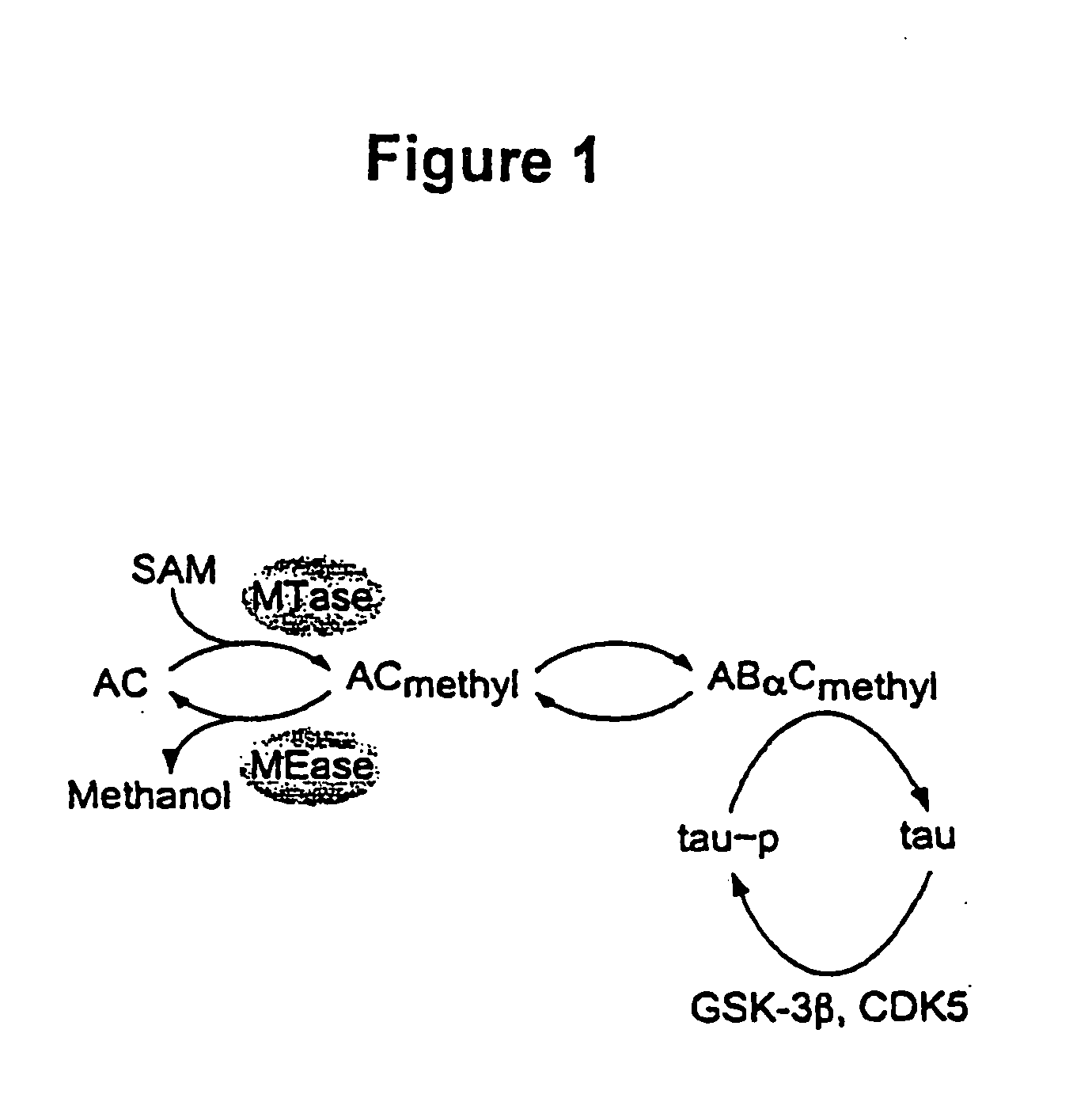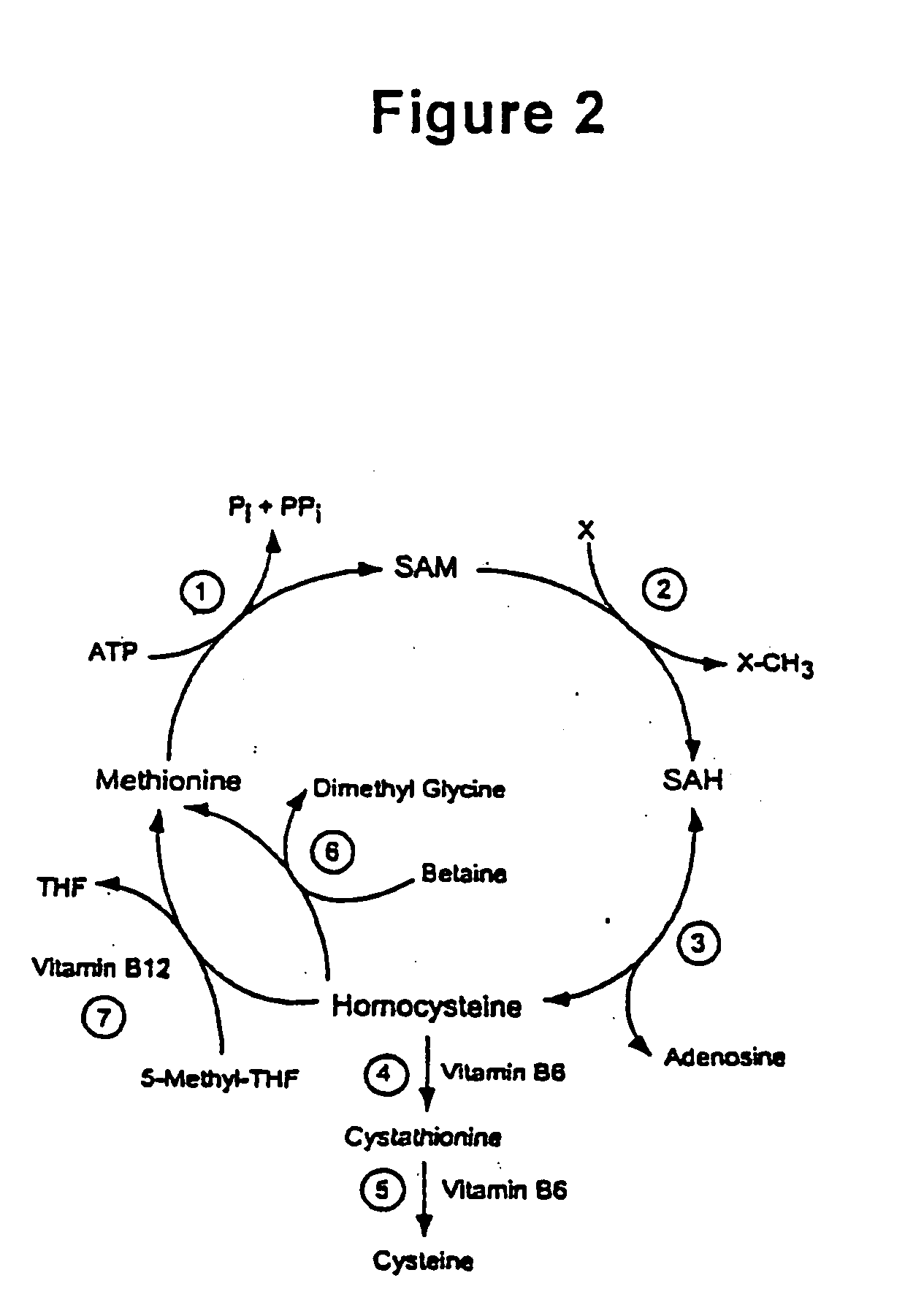Modulation of protein methylation and phosphoprotein phosphate
a technology which is applied in the field of protein methylation and phosphoprotein phosphate modulation, can solve the problems of unfavorable drug development targets, imbalance between kinase and phosphatase activities, and recognition of association so far has not provided a better understanding of ad or any other disease, so as to reduce the overall methylation rate, and increase plasma hcy and brain
- Summary
- Abstract
- Description
- Claims
- Application Information
AI Technical Summary
Benefits of technology
Problems solved by technology
Method used
Image
Examples
example 1
Methylation Assay in Partially Purified Extract Using 3H Incorporation
[0058] A cell-free extract is prepared from fresh mammalian brain tissue by homogenizing the tissue in Tris buffer, pH 7.5. The extract is clarified by centrifugation at 10,000×g for 30 min. Solid ammonium sulfate is added to the supernatant to 30% saturation and a clarifying precipitate is allowed to form for an hour. The solution then is cleared by centrifugation for 30 min at 10,000×g. The clarified supernatant is recovered and ammonium sulfate is added to 70% saturation. The resulting suspension is incubated overnight. Then the precipitate is collected by centrifugation at 10,000×g for 30 min. The resulting pellet is dissolved in Tris buffer, pH 7.5, and then further purified by DEAE ion exchange chromatography with stepwise elution. PP2A and the PP2A methylating and demethylating enzymes are eluted from the column in loading buffer containing 0.3 M NaCl.
[0059] PP2A methylating activity is assayed by 3H inco...
example 2
Screening for Agents that Alter PP2A Methylation Using Partially Purified Extracts and H Incorporation Assays
[0060] Extracts are prepared and purified and assays of PP2A methylation are carried out as described in the preceding example, except that compounds to be tested for effects on PP2A methylation also are added to the reactions. Effects of the compounds are scored relative to control assays.
example 3
Cell-Based PP2A Methylation Assay
[0061] A cell tissue culture assay is also be employed. This screen is for drugs that cause increases in PP2A methylation in SY-SH5Y cells in the absence and / or presence of homocysteine. SY-SH5Y cells are grown to confluence in 36-well tissue culture plates. After the cells have reached confluence, the growth medium is supplemented with extracts prepared from medicinal herbs in the presence and absence of 200 pM homocysteine. After a suitable time (−3 h), cell proteins are extracted into 2% SDS, diluted, blotted onto PVDF or nitrocellulose membranes, and probed with monoclonal antibodies that recognize specific epitopes for either total or methylated PP2A. Extracts that increase methylation are identified as drug candidates for further study.
PUM
| Property | Measurement | Unit |
|---|---|---|
| pH | aaaaa | aaaaa |
| time | aaaaa | aaaaa |
| particle size | aaaaa | aaaaa |
Abstract
Description
Claims
Application Information
 Login to View More
Login to View More - R&D
- Intellectual Property
- Life Sciences
- Materials
- Tech Scout
- Unparalleled Data Quality
- Higher Quality Content
- 60% Fewer Hallucinations
Browse by: Latest US Patents, China's latest patents, Technical Efficacy Thesaurus, Application Domain, Technology Topic, Popular Technical Reports.
© 2025 PatSnap. All rights reserved.Legal|Privacy policy|Modern Slavery Act Transparency Statement|Sitemap|About US| Contact US: help@patsnap.com


